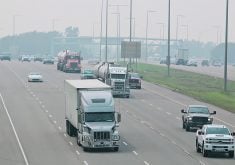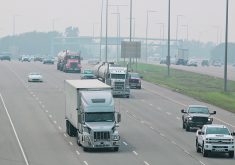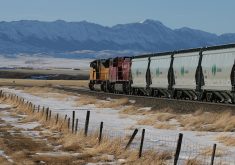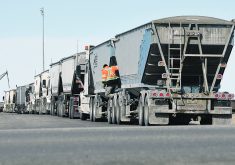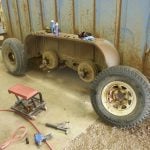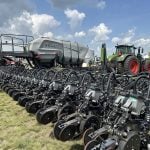Gliders, trucks that come without engines and transmissions, are being ordered by truckers and farmers who have a good but well-worn truck, but they don’t want the higher costs and reliability issues associated with some of the new EPA Tier 4i compliant engines.
When they take delivery, they install the reliable engine and transmission they’ve been running for the past five years or from a salvage vehicle.
Truckers overhauling an older Cat or Cummins are using the strategy to avoid engines in the 2008, 2009 and 2010 Tier 4i group because they are the considered the most likely to cause problems.
Read Also

New coal mine proposal met with old concerns
A smaller version of the previously rejected Grassy Mountain coal mine project in Crowsnest Pass is back on the table, and the Livingstone Landowners Group continues to voice concerns about the environmental risks.
The heavy truck industry appears to agree that the EPA mandated after treatment technology on those engines was faulty from the start, regardless of which manufacturer built the engine.
The biggest supplier of gliders is probably Peterbilt. Chris Fredrickson of Peterbilt in Winnipeg says he is selling more glider kits now than in previous seasons.
“Our glider kit customers are the guys who don’t want to deal with the modern technology,” says Fredrickson.
Over at the local Kenworth store, used truck manager Dean Willerton says the 2008, ’09 and ’10 engines with the after treatment technology were very unreliable and expensive to maintain.
“I’ve had customers call me up in tears they’re so frustrated with their engines. Guys are right at the end of their rope. Other guys come in yelling and screaming they’re so mad.
“We do everything we can for our customers, but these guys have taken a real hard blow from the EPA … We also own a lot of trucks for lease, and we’ve watched our costs escalate in the past few years. There’s definitely an extra cost burden on the owners today.”
Toromont Caterpillar in Winnipeg is doing three times as many major overhauls on highway engines as they did two years ago.
“Guys have seen the reliability troubles with the emissions technology. It costs them a lot of money in downtime and repairs,” says Lorne Lagimodiere of Toromont, adding that the upfront cost of buying a truck with the new emissions technology is also higher
“If they have an older engine, they’re more than happy to spend the $25,000 for a major. They get a four year unlimited mileage warranty and they get to keep the simple technology for a few more years.
“In the past, technological advancement was aimed at improving the engine and the truck. That’s no longer the case. The new technology is aimed at emission control. That’s why guys are doing majors on their older engines and ordering gliders.”
Fredrickson says the glider customer must have a serious phobia about new technology, because the economics of doing a glider don’t pencil out.
“It actually costs more than buying a new tractor complete with engine and transmission,” says Fredrickson.
He said if the engine needs a major rebuild it’s $30,000 plus $5,000 or more for the transmission.
Willerton, has been in the trucking business for 35 years,
“Gliders are expensive. They are not cost effective. The decision to do a glider is a bad business decision.”
Willerton says it’s easy to understand why the owners are frustrated and angry.
“One guy spent $32,000 on after treatment problems in just two years. That’s all out of his own pocket. We just recently had a trade-in that looked really good. By the time we finally had the after treatment working right, we’d spent $10,000.”
He said truck owners might feel justified in circumventing the law, but they definitely are operating outside the regulations.
“You’ll have to be careful where you go with that glider. If you think you’re going to haul a load down to California, you’re wrong.
“They’ll do a quick exhaust sniff test at the border and that’s where your trip ends.”
Willerton says Manitoba Public Insurance is looking at including the exhaust sniff test as part of the safety inspection. If the truck fails the sniff test, it doesn’t get the safety and that means no licence.
“If the tractor has the emissions apparatus removed or has the wrong engine, it’s going to get parked.”
He says it’s only a matter of time before we see exhaust sniff tests everywhere on the continent. So, while gliders might slide through for the foreseeable future, it’s not a long-term option.
But there is good news, says Willerton, and it may eliminate the need to even consider doing a glider.
“People don’t realize yet that the latest Tier 4 engines with (selective catalytic reduction) and (diesel exhaust fluid) are way better than the previous generation. The engines we’re selling in 2011, 2012 and 2013 and nothing like the engines for ’08, ’09 and ’10.
“What SCR does is take full responsibility for exhaust emissions downstream from the engine, after the combustion chamber. SCR is fully in the environmental business.
“That means the engine can now get back into the business of powering the truck. The engine is no longer in the environmental business. It’s in the trucking business gain.”
For more information, contact Chris Fredrickson at 204-633-0071 and Dean Willerton at 204-694-3874.







